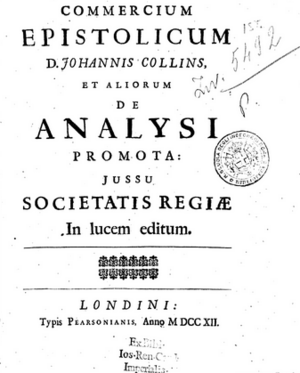John Collins (mathematician) facts for kids
John Collins (born March 25, 1625 – died November 10, 1683) was an English mathematician. He was very important for connecting with many top scientists. He wrote letters to famous people like Giovanni Alfonso Borelli, Gottfried Leibniz, Isaac Newton, and John Wallis. These letters shared new discoveries and ideas from his time. He helped spread scientific information widely. People even called him "English Mersenne" because he collected and shared so much science.
Contents
Early Life and Adventures
John Collins was born on March 25, 1625, in Wood Eaton, Oxfordshire. His father was a minister who didn't follow the main church. At age sixteen, John started working for a bookseller in Oxford. But the First English Civil War made him leave that job.
He then worked for John Marr, who was in charge of the kitchen for the Prince of Wales. John Marr taught him some mathematics. However, the war forced Collins to go to sea for seven years, from 1642 to 1649. He spent most of this time on an English merchant ship. This ship was used by the Venetians to defend Candia (now Heraklion) against the Turks.
Teacher and Author
While at sea, John Collins used his free time to study math and business accounts. After leaving the sea, he became a teacher in London. In 1652, he published a book called An Introduction to Merchants' Accounts. He had written it for his students.
This book was reprinted in 1665, but most copies were lost in the Great Fire of London. A new, bigger edition came out in 1674. He also wrote other books about math tools and navigation. One of his navigation books, The Mariner's Plain Scale new Plained (1659), was very popular. It became a textbook for navigation students at Christ Church Hospital.
New Jobs and Challenges
After the king returned to power in England (this was called the English Restoration), Collins got several important jobs. He worked as an accountant for the excise office and then for the chancery court. Later, he became secretary to the council of plantations. In 1672, he took a job managing the farthing office.
This job came with a house in Fenchurch Street. Collins hoped to open a stationery shop there and print books. He wanted to write about new math discoveries and important authors. But his plans didn't work out. His office closed when his ideas about tin farthings were not accepted. He then took a smaller job as an accountant for the Royal Fishery Company.
In 1669, he turned down a job in Ireland. Around the same time, he married one of William Austen's daughters. William Austen was the head cook for King Charles II. As his family grew, it became harder for Collins to make enough money. He started doing more accounting work and spent less time on his scientific letters.
Public Interests and Later Life
John Collins was interested in trade and public matters. In 1680, he published A Plea for the bringing in of Irish Cattel. This book discussed bringing in Irish cattle and keeping out fish caught by foreigners. It also suggested ways to help the tin, fishing, and manufacturing industries in Cornwall and Devon.
In 1682, he wrote Salt and Fishery. This small book talked about how salt was made in England and other countries. It also covered catching, salting, and cooking fish and meat. He also offered ideas to help salt-workers.
Collins died on November 10, 1683, in London. He was buried in the church of St. James.
Contributions to Science
John Collins was elected a member of the Royal Society on October 24, 1667. This was a very important group for scientists. He shared his ideas and discoveries with them. He also wrote about how to solve math problems with numbers. He surveyed new algebra improvements in England.
Collins played a big role in helping to publish many important scientific books. He helped print Isaac Barrow's books on optics and geometry. He also helped with editions of works by Apollonius and Archimedes. He supported the printing of algebra books by John Kersey and Thomas Branker. He also helped get Jeremiah Horrocks's astronomy writings published.
His Lasting Impact
About 25 years after Collins died, his books and papers were given to William Jones. These papers included many letters from famous scientists like Newton, Leibniz, Gregory, Barrow, and Wallis.
In 1712, the Royal Society published some of these letters in a book called Commercium Epistolicum. This book was important because it showed how Newton developed his ideas about calculus. Collins had helped share Newton's early work on calculus widely, which was very important for science.
See also
 In Spanish: John Collins (matemático) para niños
In Spanish: John Collins (matemático) para niños


